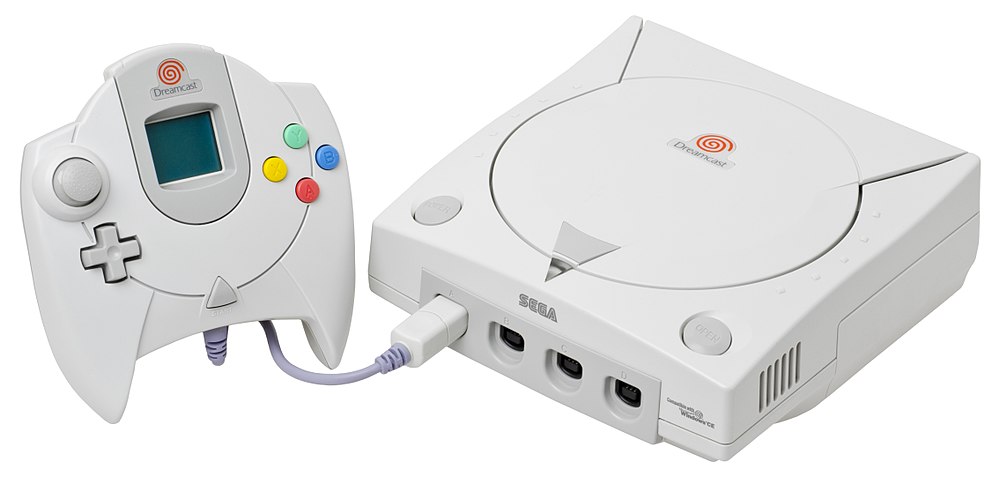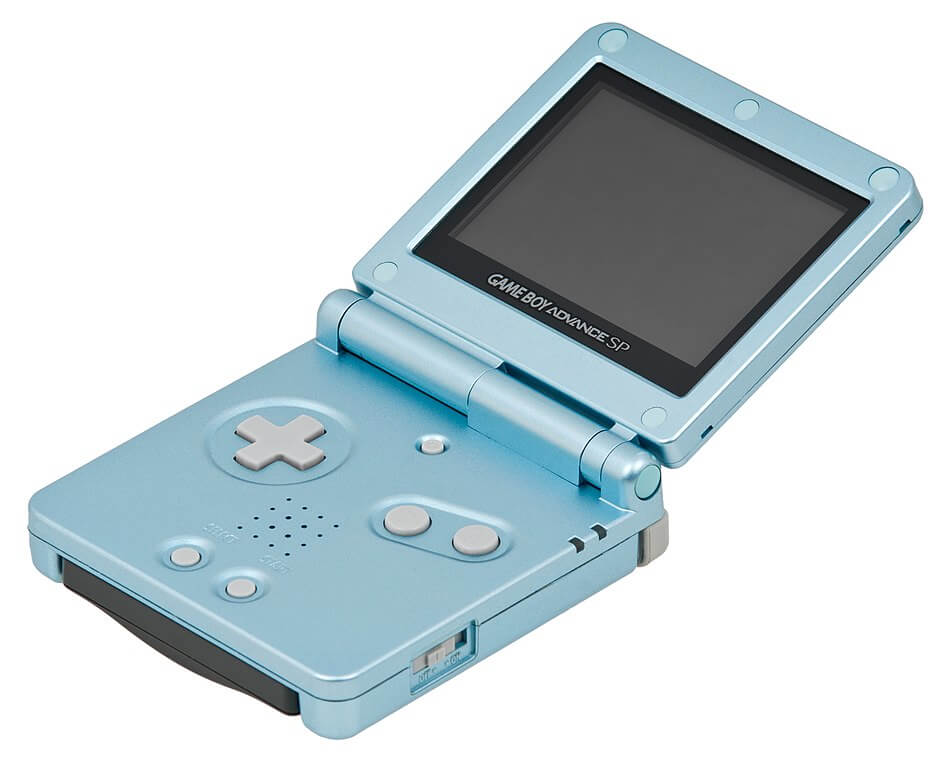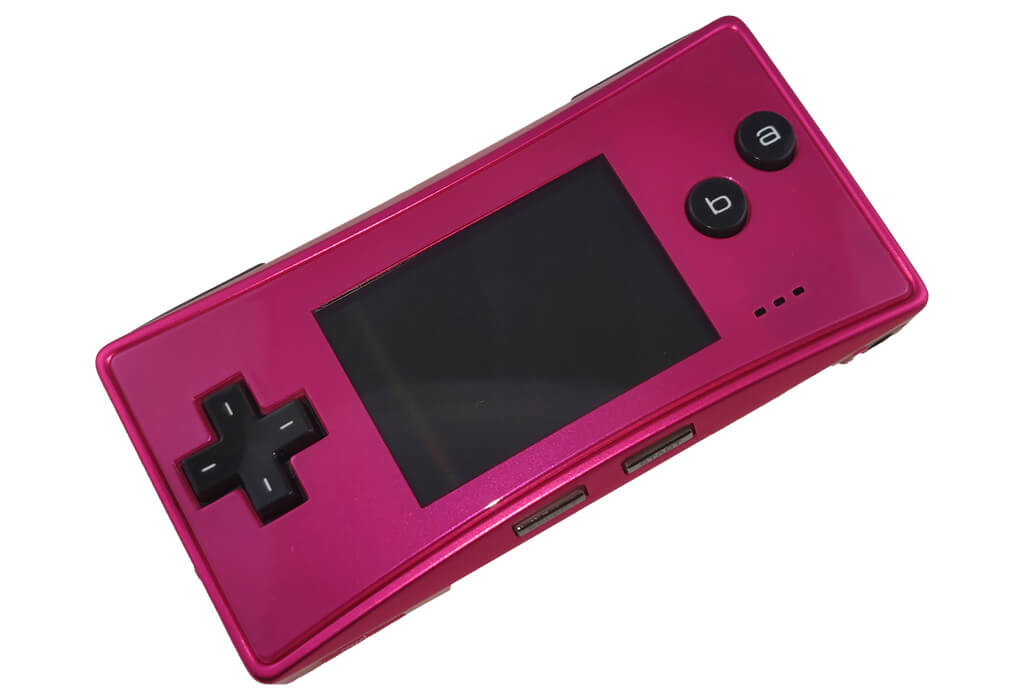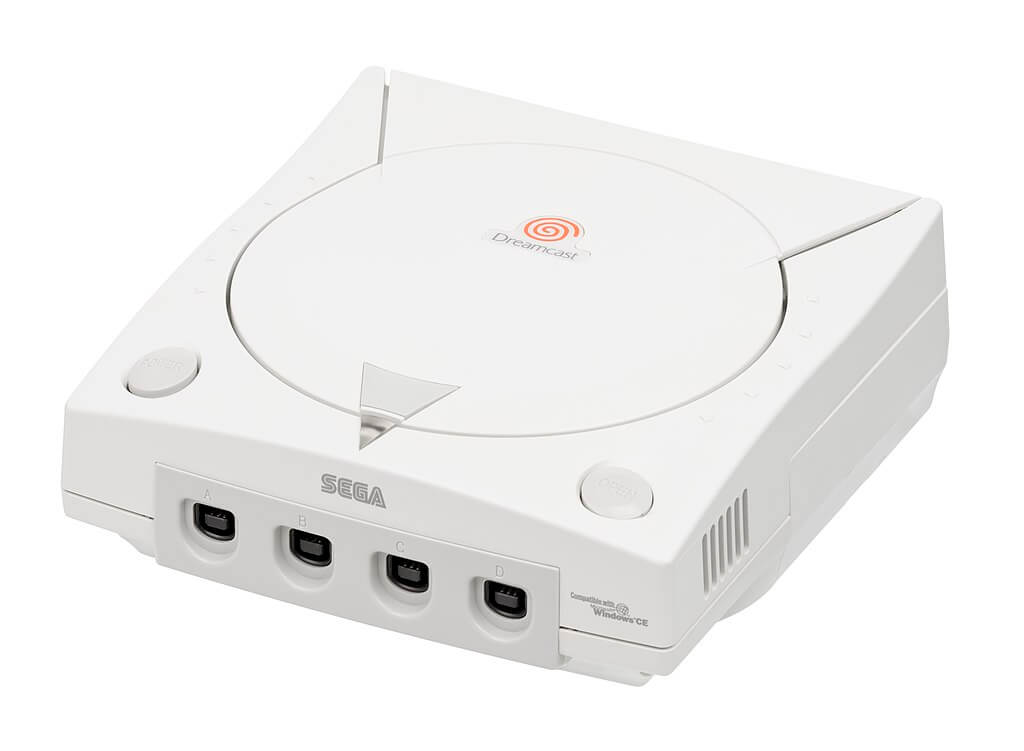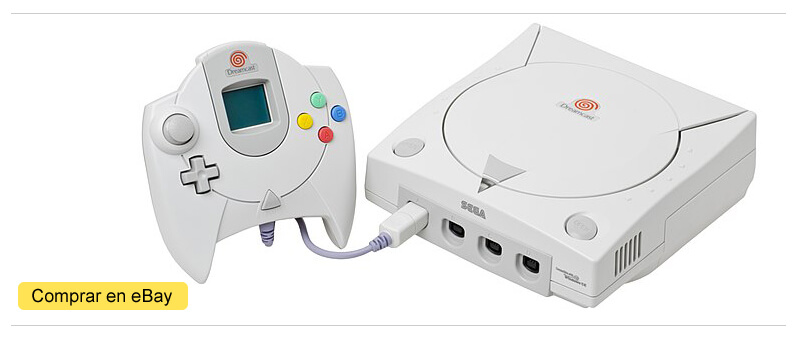The sixth generation of video game consoles, also known as the 128-bit Era, includes one of the most interesting periods in the history of video games: In a few years we experienced the fall into the abyss of SEGA, the definitive rise of Sony, despair of Nintendo and the arrival of a giant like Microsoft to face Sony. A battle of titans at the blow of exclusivities, chips, benefits, millions of polygons and a wallet, also a wallet.
START DATE: 1998
FIRST CONSOLE: Dreamcast
- Consoles of the sixth generation in Infoconsolas.
- The sixth generation of consoles, background.
- The sixth generation of consoles, course.
- The sixth generation of consoles, legacy and consequences.
- The public of the sixth generation of consoles.
- The games of the sixth generation.
- Collect sixth generation consoles.
- Buy consoles of the sixth generation.
- FAQ Sixth generation of video game consoles
Consoles of the sixth generation in Infoconsolas.
Before getting into the matter, here are the sixth generation video game consoles analyzed at Infoconsolas, little by little we are updating and improving the articles, so I ask for your patience and understanding. As you can see, you will surely discover some unusual console that you were not aware of, there are more 128-bit consoles than people imagine!
The sixth generation of consoles, background.
The fifth generation of video game consoles were years of transition in which the video game market and industry changed forever. The passage from 16 bits to 32 bits and 64 bits, meant an evolution towards three-dimensional worlds that had come to stay, from that moment on the ability to handle polygons and textures of our consoles would be a fundamental aspect. The public demanded 3D and the industry would give them 3D.
For the previous 5th Gen. it was no longer enough to improve the performance of our consoles as happened from the NES to the SNES for example, the fifth generation brought much more drastic changes such as the arrival and consolidation of optical formats such as CD-ROM and the disappearance of cartridges in home consoles. Regarding video games, the developers had to learn to manage to change the worlds in 2D for 3D, without having a keyboard and mouse as they had on PCs. One consequence of these new worlds open to 3 dimensions is that both Nintendo and its competition had to come up with adapted controls: the analog stick and triggers designed for FPS were added to the traditional crosshead.
There were many companies that tried to enter the succulent market for video game consoles, but the arrival of the giant Sony together with the loyalty of users to Nintendo and Sega, made all those launches remain mere attempts without a path. On the other hand, Sony and its PlayStation showed that it was here to stay, humiliating the veterans SEGA and Nintendo: The Saturn only had some relevance in Japan and the Nintendo 64 held its own but far from the success of the PS1, a console that swept becoming the best-selling of the generation, with more than 100 million units, crazy.
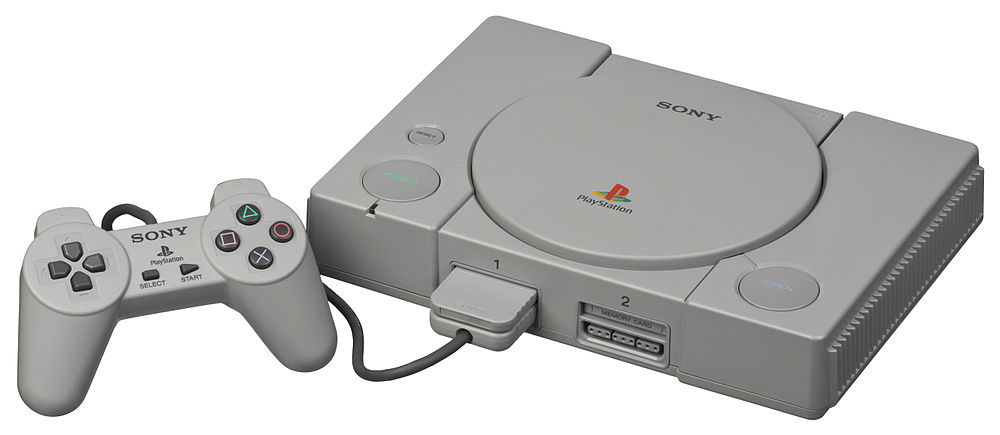
It was precisely thanks to the PSX and its target audience made up of adults and teenagers, that video games broadened their bases like never before. The PSX succeeded in turning what until now had been considered a child’s game (video games) into a hobby for adults, with a catalog adapted to the tastes of those of us who were already on a motorcycle or thought of getting the car license… Sony managed to keep those of us who were getting older hooked, something that until now only PCs had achieved on a smaller scale. Video games were already considered entertainment for adults, there was no longer any reason to stop playing when you reached a certain age, this is something that we will always be indebted to Sony for.
But not everything was going to be pretty, as we have already mentioned, the arrival of the PSX had a great impact on the video game industry, annihilating all the competition that was not up to the task, such as the Atari Jaguar, Virtual Boy or 3DO, among others. , as well as changing the hierarchy that had been present since the mid-1980s: Nintendo was dethroned to second place and Sega was relegated to a humble third place, leaving it very touched. Sony would set the pace from then on and only the big companies would dare to compete with it.
The same or worse than what was mentioned in the previous point, was the disappearance of the arcades as we knew them, the arrival of machines such as the PSX or N64 equaled or surpassed the traditional arcades of the neighborhood arcades, those of the 5 hard as we could afford. In this way, a natural cycle in which consoles and arcade machines had coexisted perfectly for decades was broken. The arcades were no longer the meeting and reference points, the developers launched their novelties directly on the consoles and we, who did not know how to value what we had, stayed in our homes throwing our vice at Final Fantasy VII or Metal Gear, while hundreds arcades closed down in our cities. Absolute sadness.
The PSX was owner and lady of the generation and little by little its catalog of games was adapting to all audiences, the Saturn was losing strength, Sega focusing its efforts and resources on its next console and Nintendo focused on itself, passing to carry out a strategy of protectionism in which the universe of Nintendo games and pets hatched, adapting to 3D and launching new franchises, the third parties had stopped pampering it, so it would have to create its own catalog of exclusivities with the help of RARE. And boy did he do it.
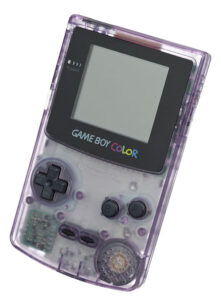
Regarding the portable consoles of the fifth generation…
Nintendo continued to be the undisputed queen, managing to replace its well-known original Game Boy with the smaller-sized Game Boy Pocket and the higher-performance Game Boy Color, both consoles being compatible with the first, a master move. It is true that some competitors such as Game.com or Neo Geo Pocket emerged, both very interesting proposals, but it was not until the arrival of the wonderfully balanced WonderSwan and its variants, made by Gunpei Yokoi himself for Bandai in the exclusive market Japanese, that Nintendo put its foot on the accelerator to launch what would really be the continuation of the Game Boy, a 32-bit Game Boy as we will see below.
The 6th generation of consoles, goodbye to Sega, welcome to Microsoft.
As we have already mentioned in the previous point, the overwhelming success of Sony in the previous generation caused companies to think about it a lot before entering to compete in the video game market, the result was that in the 6th generation there were fewer powerful proposals than ever, only the big ones remained. The 128-bit battle was exciting: With a Sega that was ahead of the rest, a Nintendo wounded in its pride, Sony with the world at its feet and a giant like Microsoft that, like Sony had done, was planning its foray into 10 years view.
Let’s see case by case:
The Dreamcast, the latest SEGA console.
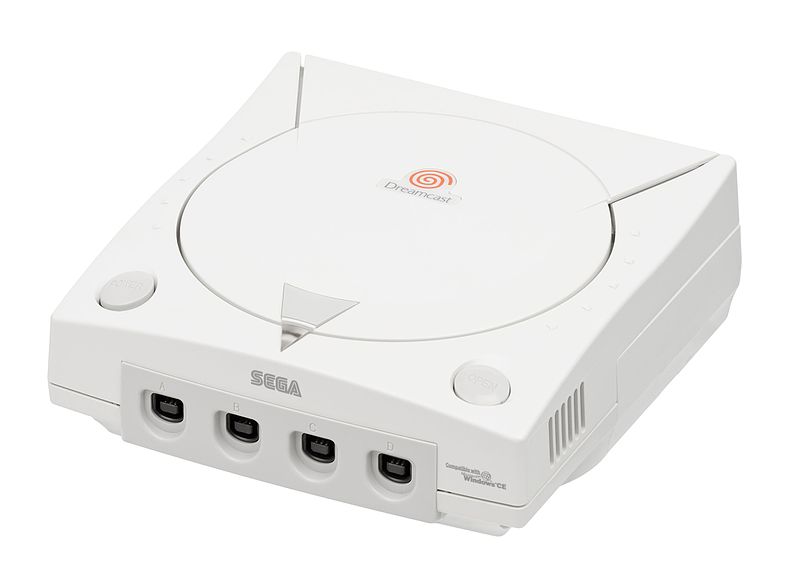
The failure of the Saturn clearly marked the way for the future SEGA, with more time to focus on its next console, as it became clear that there was no peripheral or expansion that could save the Saturn in the face of the overwhelming success of the PS1, Sega began to work with two different research and development teams, one external and one internal. The guidelines were clear, the new Sega console had to be revolutionary, far superior to what is present, and most importantly, its architecture had to be accessible enough to be very easy to program.
And they succeeded, the Dreamcast turned out to be a much superior console to the existing 32 and 64 bits, so superior that based on the console itself, the Naomi arcade motherboard was made, just the opposite of what it had been until now ( consoles emulated arcade boards). With an architecture very similar to that of the PC, so much so that Microsoft itself designed its own Windows as its operating system, programming for the Dreamcast was much easier than doing it for its previous consoles. On the other hand, the Dreamcast included a modem in the console itself to be able to play online on a regular basis, something that most of us had never seen on a console, and it was ahead of its competitors with the services Dricas (Japan), SegaNet ( USA) and DreamArena (Europe). As if this were not enough, it had the VMU, a visual memory card that was much more than a card, a mini portable console to be able to continue playing an adaptation of your DC video game anywhere, with mini-games and accessories , being prepared to play doubles.. No wasting time in class with math or science!
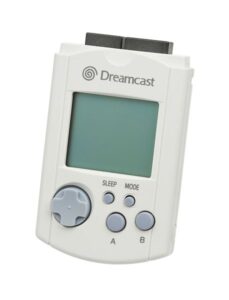
Yes, the Dreamcast was quite a revolution in its time, a pity that we were not aware at the time… When it was launched on November 27, 1998 in Japan and in 1999 in the rest of the world as the first video game console of With the sixth generation, the first 128-bit console, Sega’s reputation as a hardware company was in tatters. His games and arcades continued to triumph, but peripherals such as the Mega CD, 32X or the Saturn video game console itself, had not lived up to the expectations of his followers, who had mostly migrated to the PSX, allowing themselves to be conquered by the 32 bit from SONY. But this lack of a solid base of believers was not his only problem…
The fifth generation of consoles, due to its price and the great exponents of the 16 bits that were launched in its last years, was a generation that was slow to establish itself. Consequently, in 1998 and 1999, most gamers had only made the investment in a new system 2-3 years in the case of the PS1 and 1-2 years in the case of the N64. Changing the system 2 years after leaving us a pasture was something that did not fit into our plans, and we did not do it.
But as if this were not enough, in 1998 and 1999 the developers were taking the “trick” to the PSX and they were launching authentic great games, games so good that they were able to face the Nintendo 64 and the Dreamcast. It is true that the difference between systems was very noticeable, but the expertise in programming the Sony console and the possibility of making games on 2,3 or 4 CD-ROMs, made the PSX look at the Dreamcast.
But… Let’s see… Soul Calibur, Sonic Adventure, REZ, Resident Evil: Code Veronica, Shenmue, their arcade conversions… They are games that are far superior to 32-bit games in every way. How could Sony and your ps1 compete with that? With the hype, as the release date of the Sega console was approaching, Sony was announcing new data of what would be its next console and unlikely figures and stories of Chinese missiles and PS2 CPUs that they would control were leaking. the world. Everything that surrounded the PS2 project sounded like technological progress and revolution, the result was that with the exception of the first week in which Sega had extraordinary sales of its most faithful, most players were waiting to know the proposal. from Sony without experiencing Sega’s.
When Sony launched its PS2 in the year 2000, it was the coup de grâce for Sega’s console, even though it had blatantly lowered the price in key territories such as North America, Sega failed to place enough units to keep its console on the market. and before the new success of the PlayStation 2, in March 2001 it stopped producing consoles, becoming a third party. From being a pioneer, innovator and the first 128-bit console, in just 3 years the Dreamcast became Sega’s last console, with 10 million units sold. Once again, we were not aware of what we were losing.
PlayStation 2, the great winner of the 128 bits.
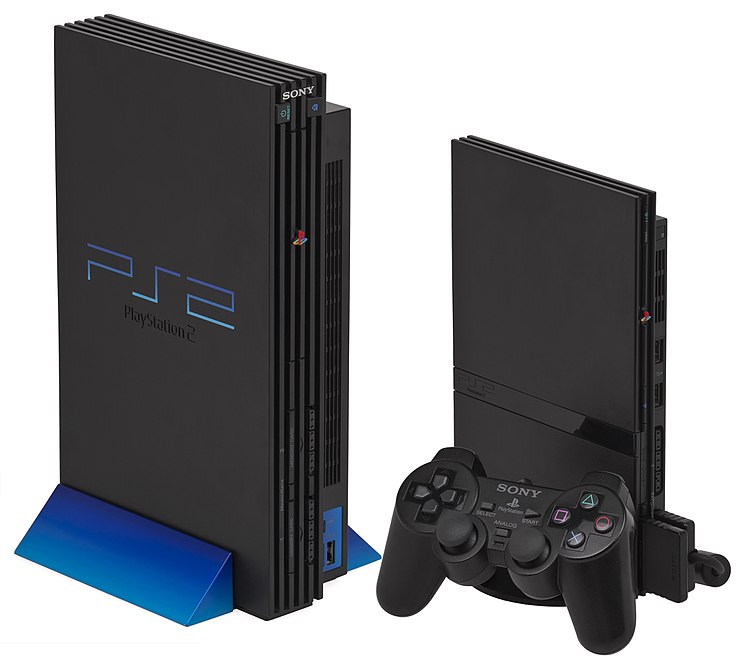
The PS2 was destined to succeed in the 128-bit generation, with millions of new fans delighted with its first console, Sony handled the times masterfully, sinking the launch of a great console like the Dreamcast with only information, rumors and alleged leaks. The world expected and wanted to see the new Sony console in motion, and the truth is that the console did not disappoint at all.
March 4, 2000 was the date chosen for the launch of the PS2, launching a few months later in the rest of the world. Long queues and empty shelves were the result, PS2 offered almost everything that had been promised with an ace up its sleeve to convince parents and other adults (those who paid), the console incorporated a DVD player with a price very similar to that of any vintage DVD player. The formula would be like this:
VIDEO GAMES CONSOLE + DVD= Expansion of the target to the WHOLE FAMILY.
Master play. Sony’s new console managed to get video game consoles out of the girls’ bedrooms, and definitively conquered the living rooms with the main televisions in homes, under the brand name of “multimedia system”. “Multimedia”, a cursed word for generations, was perfectly integrated into the Sony console without making the price of the console too expensive, as had happened with other consoles before. The format chosen by Sony and the possibility of playing movies, became the definitive value proposition against the competition, being the best argument to acquire the console in its beginnings, in addition to its benefits as a video game console. Sony offered families the leap from VHS to DVD, a true revolution of which only those of us who lived through it are aware, something very similar compared to the leap from cassette to CD. In practice, the DVD became the perfect excuse for many young people to ask their parents for the PS2, and what is more important, they accepted.
But… And the PlayStation 2 as a video game console? Well, far superior to everything seen, including the Dreamcast, since by having a faster CPU and GPU, more and better RAM memory and a format much superior to GD-ROM such as DVD, it quickly became the console title most powerful in the history of video games (up to that point). A fatal blow to the Sega console, which made most developers turn to the new PS2.
In this way the PS2 conquered the 128 bits and an entire generation of video game consoles, without the rest of the contenders even appearing. Thanks to the PSX, the trust in Sony was such that the market quickly took over PS2, becoming over the years the best-selling console of all time (2020) with 155 million consoles sold, a real madness that tells us until What point Sony was the queen of video games, never a console had achieved something similar and best of all, is that Sony did not disappoint its faithful…
Year after year the PS2 launched games that theoretically squeezed 100% of the console, only to publish a new and better game a few months later that again broke the supposed technical limits of the console. The PS2 catalog was immense and, as was the case with the portables and the Game Boy, even when superior systems were launched, the public trusted Sony and, due to the difference in performance, it was not profitable to invest in a new system for those who were already PS2 owners. The expertise in programming for the PS2 by the studios concealed the technical differences with superior consoles such as the Game Cube or Xbox. The PS2 was definitely a great console up to the circumstances that once again swept its competitors.
oh! And yes, as with the PSX, piracy also played a transcendental role in the Sony console, the public taking it for granted that sooner or later it could be pirated, they were completely right and again it was a fundamental factor when choosing console and even the DVD recorder for the home PC, since thanks to the Internet users could record their own games. All very nice except for the developers.
Game Cube, Nintendo’s 128-bit
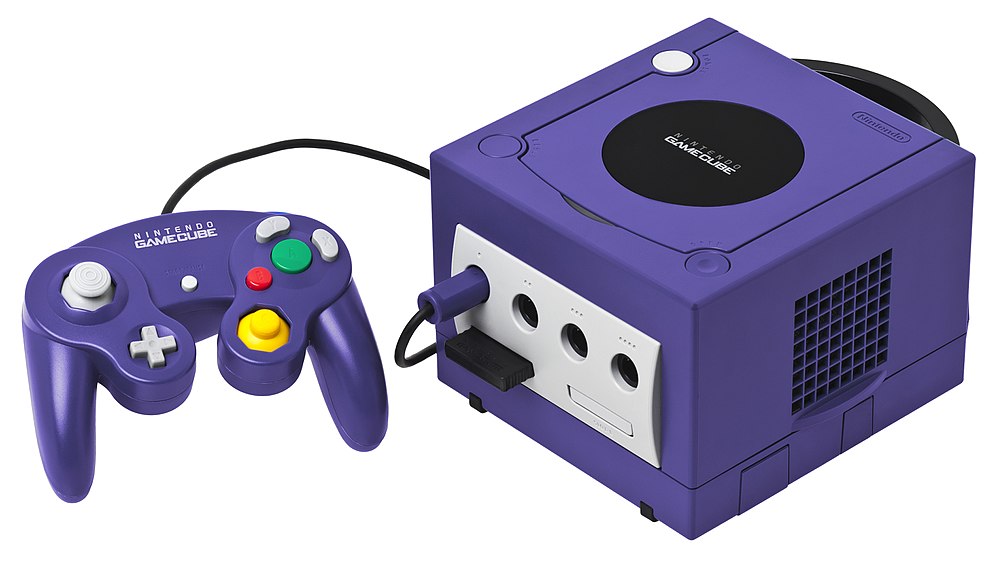
Nintendo’s proposal for the 128-bit generation was the Game Cube. Launched at the end of 2001 in Japan and North America and in mid-2002 in Europe, at a fairly cheap price for a launch, despite its certainly childish appearance, the Game Cube was more powerful than the PS2 and the Dreamcast. In addition, this time Nintendo had learned its lesson and made an effort to correct the errors of its previous Nintendo 64:
- The use of the Game Cube Disc as a format: The Game Cube left behind the expensive cartridges and adopted a format created by Panasonic (hence the Panasonic Q), a 1.46 GB mini optical disc that is very cheap to produce and more complicated to pirate than DVDs.
- The third parties: With the N64 and its loss of influence, Nintendo found how difficult it was to get exclusivities for its console without being in a position of superiority, the cartridge being the big problem exposed by the companies. The adoption of the Game Cube Disc and better conditions for developers made it easier for many more titles to come to the Nintendo console, as well as temporary and console exclusivities. By the end of its commercial life, over 600 video games had been released for the GC compared to 387 for the N64.
As we have seen so far, we have a Nintendo console, more powerful than the PS2, with an optical format and with third parties supporting it, all this at a good launch price, US$199. How did Nintendo’s Game Cube fare? Well bad, really bad if we compare it with the PS2 or the rest of the most popular consoles previously released by Nintendo. The Game Cube sold approximately 22 million units worldwide, a number well below the 155 million units sold for the PlayStation 2, also falling short of the Nintendo 64 itself with 33 million consoles sold.
The bad numbers of the Nintendo console did not correspond at all to its features or video game catalog, which demonstrated its superiority over the PS2 in conversions of the same title such as the mythical Resident Evil 4, in fact, the Game Cube It is a magnificent console with great games and the only way to enjoy the entire Nintendo universe, a decisive factor for all its faithful. But then what happened? Basically its commercial failure was for these 4 reasons:
- The market was already crowded, it was released too late, Sony and its DVD had crept into countless homes and the kids who hadn’t gotten the PS2 yet were saving up to buy it when it came down a bit in price. Sony’s console had been everything that fans expected from it, only the most faithful nintenderos waited to see Nintendo’s proposal before deciding.
- Nintendo’s children’s image, even launching a more powerful console and with authentic great games, Nintendo still retained that image of “for the whole family” from which teenagers and the public that were already over their twenties fled like crazy. We liked the Nintendo universe, but we were afraid to keep a limited catalog reduced to pets and pastel colors, something that with the almost 4,000 video games that were published for the PS2, obviously did not happen.
- It couldn’t be hacked. As simple as that, the PS2 triumphed in part in the market because the games, once the chip was installed, we appreciated DVD if we knew how to mess around or, failing that, there was always where or who to buy, with the Game Cube no. You are 17 years old and you are not a liberal capitalist sensitive to the work of programmers who live in other continents, what console did you buy, the one that can be hacked or the one that cannot? Well, that… Before we were not so sensitized on this subject nor did we value the “original” so much.
- The classic Xbox, with which it practically coincided in the release dates on the different continents, so it had to fight against the new Microsoft beast to get the crumbs that Sony had left.
And basically for these reasons, this magnificent console that is Nintendo’s Game Cube did not succeed, a zero-media machine whose sole objective was to make us enjoy the best games. At the very least, and despite its sales, Nintendo supported it considerably until its successor arrived, having an assortment of interesting peripherals such as the adapter to play games on Nintendo laptops or even to connect the laptops themselves as controllers, something that without It certainly gave a lot of play in adapted titles.
Xbox, the most powerful 128-bit console.
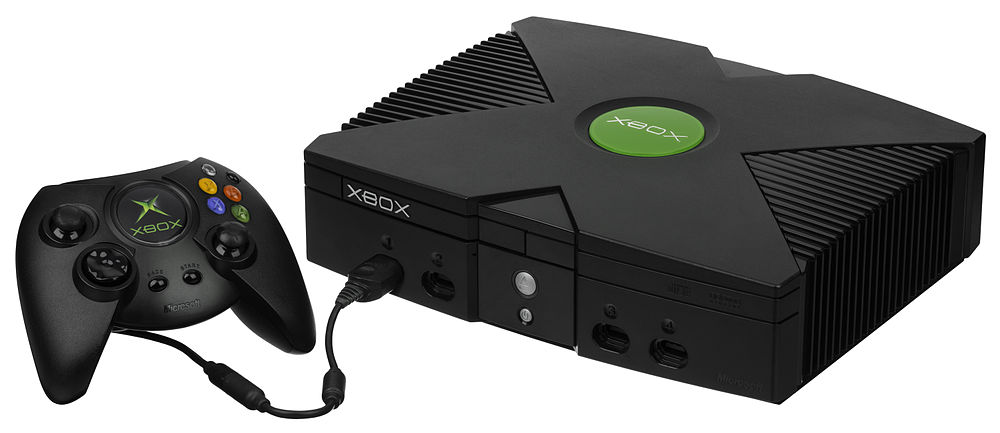
Until now we have seen how since Sony’s incursion, it had beaten a thousand and one consoles from different brands such as NEC, Commodore, Panasonic, Apple, Atari or Bandai in 32 bits, humiliated Nintendo and even kicked Nintendo out of the market. our missed SEGA in the 128-bit era. Sony had changed the rules of the game and was the one who set the rules, to enter the video game market you had to be a big player, have enough resources to research, develop and produce cutting-edge hardware superior to everything seen, spend a million in advertising, being able to launch the console cheaper than what it costs you to manufacture it to capture the market and hope to earn profits with video games… and finally, have enough capital to introduce yourself knowing that the profits might not come as even in the console generation itself… Sony had set the bar very high, thus vetoing the entry of any new competitor…
Until Microsoft arrived, a giant that played by the same rules and looked Sony face to face without batting an eyelid or even blinking an eye. Microsoft had been studying the market for years, seeing how the video game console industry was getting bigger and bigger, without making any profit from that cake and what is worse, with the possibility that the new consoles would affect to the sale of new PC equipment, and there he really had a lot to lose. Microsoft was perfectly aware of the potential that existed in the video game console market, as well as the shortcomings that it had to exploit: a good Internet service superior to that of PCs was lacking and that the United States once again had a Made in America console, to supply to its own domestic and patriotic market, even though the console in question was made in China.
In 1999 war drums began to be heard and in 2000 a prototype was presented to the press, Microsoft entered the game with practically everything against it, but with a perfectly studied planning, its first console would be a letter of introduction for a new generation of consoles. They knew perfectly well that they could do little or nothing commercially against the PS2 and an already crowded market, so their console would be a message to the next generation: “Look what we know how to do, in the next generation you can trust us.”
In November 2001 in the United States and in mid-2002 in the rest of the world, the original XBOX was launched, the first console with which Microsoft would tell the world that they were more than ready to do battle with Sony. The XBOX was superior to the PS2 in all aspects, more powerful, better features, better services such as XBOX Live, incredible games that showed its graphic superiority, an internal hard drive offering a thousand possibilities, with a ridiculous launch price of US$300 for everything it offered us, in fact losing money on each sale since the console cost more and to top it off, a PC-like architecture, something great for PC programmers who had no problem migrating to the console and thus make true masterpieces from the beginning.
And the classic Xbox fulfilled its mission, which was by no means to outsell the PS2, but rather to present Microsoft’s new brand, the Xbox, to the world as a high-quality, competitive and practical product. technologically superior to its competitors. Obviously, the fact that it came out after its main competitor, the PS2, did not help it at all, especially when it coincided in release dates with Nintendo’s Game Cube, a magnificent console that had nothing to envy regarding its graphic capabilities and with which had to fight directly for the few users who have not yet decided on a PS2. But the first XBOX console did not try to conquer its generation, it was a message that said: “Look what we know how to do, in the next generation you can trust us”… Microsoft’s next console sold 83 million units, 4 less than the PS3, crazy.
Sticking to the sixth generation, the result was that the classic Xbox turned in good numbers for its first console to market, selling a total of 24 million units worldwide, falling far behind Sony but surprisingly ahead of Sony. Nintendo and of course, SEGA.
The Xbox was a technological beast that came to impose itself on its rivals at the stroke of a checkbook, the US$300 that it cost at its launch were nothing if we bought a PC with the same features, the companies that had traditionally been dedicated to the world of PC, they turned to the new Microsoft console, and when comparing the different versions between the multiplatforms… the normal thing is that the XBOX came out on top. And the hack? Even in this the XBOX came out ahead, in addition to being able to run the backup copies of youth, having a hard drive and PC architecture, if you took it to the right place they would take it out with all the console emulators, MAME and some 12,000 games on a brand new hard drive. Retro came to 128-bit consoles thanks to piracy.
Also highlight the great feat of Microsoft, with the reference of the Sega Dreamcast and PCs, laid the foundations for online gaming on consoles with its wonderful service at that time, XBOX Live. Now yes, the online came to the consoles in a successful way as a simplified service that unified and centralized all the online modes of the video games published on its console, and promoting live voice chat thanks to its controls (giant by the way in its US version). Dreamcast tried, but XBOX succeeded, seeing all the possibilities offered by its online service was to see the future of video game consoles.
Any other home console?
Yes, there really were some companies that ventured to compete with the “big 4”, achieving very different results, here are some:
- Nuon: A technology/chip to integrate into DVD players, turning them into a video game console with features similar to a Nintendo 64. Despite being an interesting idea, it was a failure with a tiny catalog of titles.
- XaviX: At the time in 2005 I predicted it and I was right (it’s written, I had to say it), its motion capture technology and immersion in video games would be the proposal for Nintendo’s Wii. And so it was, but it went so unnoticed that it ended up being converted into the Domyos Interactive System console, that is, the Decathlon console. A console ahead of its time that could do nothing against the big ones.
- V.Smile: Be careful with the V.Smile, which is very funny but has sold much more than we think and has franchises that other consoles would like. With a technology between 16 and 32 bits based on an inexpensive chip from Taiwan, the V.Smile focused on children and education. Round play, no research and development costs and monopolizing an audience that had ignored the 128 bits, the smallest of the house.
And the portable consoles of the sixth generation?
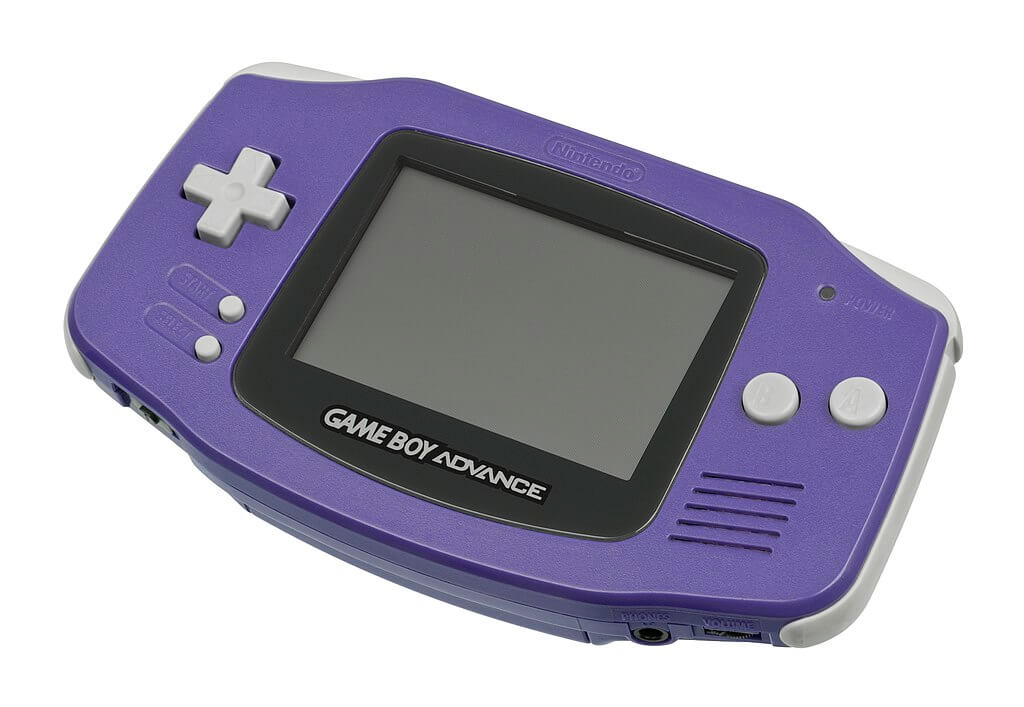
This is a really interesting generation for portable consoles, after more than 10 years of absolute reign by Nintendo and its Game Boy, Bandai had launched the WonderSwan, a magnificently balanced and very economical 16-bit console, successful enough in its country of origin (Japan) enough to erode the reign of the Game Boy Color. The Game Boy and its different versions were no longer the first option for many to acquire a new portable console, the fact that most players already had the classic Game Boy compatible with most of the new games, and the well-known franchises of the manga and anime from the Bandai universe brought to its WonderSwan, caused Nintendo to see its reign in danger… Did WonderSwan put the Nintendo portable in serious trouble?
Without problems, Nintendo had been working for years on what would really be the successor to the Game Boy: The Game Boy Advance, a 32-bit portable that in practice was dedicated to bringing the magic of 16-bit home consoles to our hands, magnifying its exclusive video games and turning out to be a “super 16-bit”, that is, a powerful 32-bit machine focused on offering us the best 2D games in history.
The Game Boy Advance turned out to be a perfect successor to the original Game Boy, having true jewels in its catalog, many of them recovered from the Super Nintendo, in those years nobody demanded polygons and 3D in portable consoles, we came from the Game Boy of 8-bit, so we all understood that the logical evolution of laptops was to be able to play 16-bit games on a laptop, and that’s what happened. But beware! Make no mistake, as many of its games show, the GBA also showed that it could be up to the task in 3D with games that reminded us of the first PSX titles at a graphic level (without reaching its graphic level), something that Titles like V-Rally 3 or James Bond 007 would prove it.
As usually happens with successful consoles, the GBA had a long commercial life from 2001 to 2010 and had 2 revisions, the Game Boy Advance SP anticipating the future design of Nintendo’s portables and the Game Boy Advance Micro, a wonder technique, a beauty, a whim, a finishing touch to end the GBA era with one of the best screens that is still remembered for its small size.
But not everything is Game Boy, it was in this generation when various companies that did not intend to compete with Sony in home consoles, tried their luck in the portable market with very interesting products:
N-Gage, Nokia’s handheld
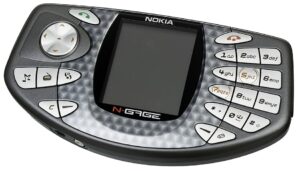
With more than 3 million consoles sold, the N-Gage was on paper a worthy opponent for the GBA: Launched by a company that was eating the world in those years, with 32-bit power and better 3D features, supported by third parties and… It was a telephone! A mobile phone, obviously, the perfect phone for any child or adolescent, a 2 in 1 that united the two objects of desire of any kid of the time, with controls as God intended to play 32-bit video games at the bus stop. bus.
The theory was perfect, but the target it was focused on did not have the money they were asking for to have a mobile phone/console (the equivalent of US$400 in 2020). The N-Gage was a great idea for that time, which would be completely forgotten a few years later when video games were adapted to touch screens, instead of phones to video games as the N-Gage did. They bet on giving us some good controls on our phones, but the path chosen by the market was another.
On the other hand, three design flaws were crucial to its commercial failure: the posture to talk on the phone was ridiculous, in the first model to change a game we had to open the back cover and the screen format proved to be useless for most of the games.
Tapwave Zodiac, another laptop ahead of its time
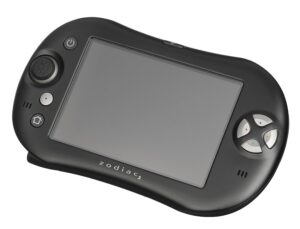
Here’s another one of those prodigious phenomena, a console from 2003 based on intense online promotion of its amazing technical features through Internet channels, which deludedly intended to confront two great ones: Nintendo and Sony about to launch their DS and PSP.
These types of consoles are a classic: an Asian company realizes that if you put together the most current components in a casing, a cucumber comes out that leaves current systems at the height of bitumen. Launch the trial balloon to the online media promoting features and they bite at first, eager to see everything that the console can offer. A little smoke here, a little makeup there… We have a thousand and one illusions about the machine that is about to arrive, and once it is launched, four things usually happen:
- The big ones in the sector announce or are about to launch their new most powerful consoles.
- A lousy distribution and global logistics makes its launch a failure commercially speaking.
- It doesn’t get a fifth of all the third party support it had secured.
- It costs a pasture. A pasture for a system whose days are numbered.
GP32, emulators from Korea
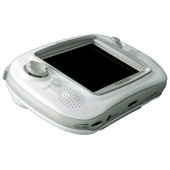
Launched in November 2001, this Korean handheld console is completely different from anything we had seen up to that point, the GP32 is a 32-bit console whose purpose was not to compete with its contemporary consoles, its objective and strong point was to execute retro console and computer emulators, offering us thousands and thousands of games in the palm of our hands.
A marvel gentlemen, some visionaries who paved the way for the world of retro video games. Back in 2001, the Koreans from Game Park were able to see the market niche, the business possibility of a phenomenon that until then was only limited to the emulators of our PCs, being a rather opaque hobby because in practice, It was considered piracy. The GP32 was the first video game console intended primarily for playing retro video games. Wonderful, brilliant, a company already allocated in 2001 the necessary resources to manufacture and market a console for the retro. Quite a bet with a lot of money invested at stake.
And the fact is that although retro is fashionable today and we have the big companies in the sector launching their own retro consoles, in those years the retro sector was made up of a minority of enthusiasts who enjoyed replaying pixelated games, while the majority of gamers They did not release the command of the play. In this context, Game Park dared to launch a portable console for a minority of nostalgic gamers, paving the way for the big players in the sector to realize that there was also business in the retro scene.
It is thanks to companies like these that today we have a retro-focused video game sub-industry. Later, dozens of consoles with the same concept would come, but the GP32 was the first, it did not have a great commercial success, but it was enough to show that the retro business model worked.
Remember once again at this point, that in those years everything related to retro video games, with the exception of pure and simple collecting, was inevitably linked to the piracy of ROMs and emulators. If you wanted to play certain arcade games, you had no other option but to install MAME, the whole process being completely free. Unlike today, when we have a large part of the retro titles within our commercial reach, those were years in which users who were fond of retro had to make a living until, little by little, the companies realized that we were willing to pay good sums of money to build our own cabinets or modify our consoles like the XBOX to play games from 15 years ago. It’s funny, but the hack paved the way for the commercial retro industry culminating in the most current release of the mini consoles (2020).
The 6th gen. of consoles, legacy and consequences
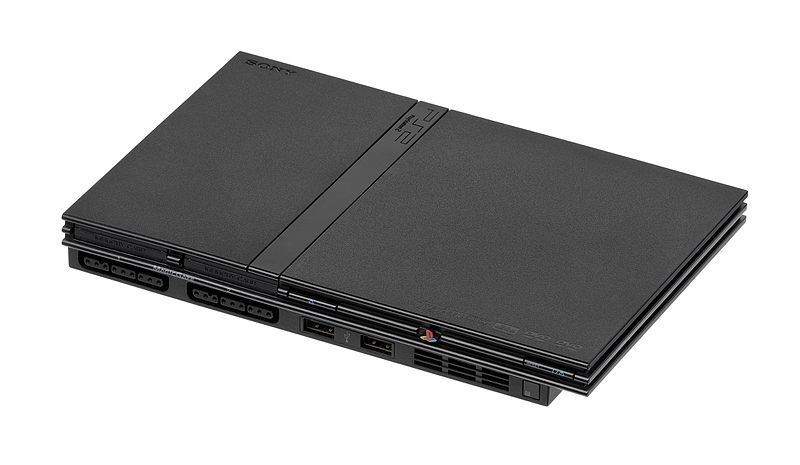
The sixth generation of consoles served to further strengthen the reign of Sony, the Japanese company had come to stay and one more generation, was well above its competitors in number of consoles and video games sold. Let’s see the consequences and aspects to take into account left by this generation:
- The traditional home console business model no longer worked for Nintendo and Sega. Sony’s prestige and reputation was so great that it was no longer enough to bring to market a console superior in performance to the contemporary competition, from that moment they would have to be much more creative if they wanted to continue in the hardware market, the power would pass to be a thing of Sony and Microsoft.
- As with the PS1, the player base continued to expand, there was no age to stop playing video games. Video game consoles, mainly the PS2 and its DVD, became a permanent part of the room.
- The phenomenon Pro Evolution Soccer, PES. Something very curious happened, the PES saga was so successful that many players only bought the PS2 to play PES, they didn’t like video games, they liked football that PES had masterfully captured on consoles. In the US something similar happened with American football and its XBOX.
- Sega and its Dreamcast laid the modern foundations for what would be the video games and systems of the future. Its online services and video game mechanics such as Shenmue are a benchmark for what came later.
- The PS2 showed that it could coexist with much superior consoles for many years, coming to have a commercial life until 2012, becoming one of the longest-running consoles in history.
- The first consoles destined to emulate other systems arrive. The retro demand is evident, although the big ones in the sector would take many years to react.
The public of the sixth generation of consoles
Generation after generation, the base of video game console players was expanding, with attacks on video games as such still kicking in, blaming them for homicides and a thousand misfortunes, the good work of companies when it comes to classifying their products by age and a greater organization at the lobby level, they were able to counteract the attacks suffered in a much superior way compared to the 90’s.
New young players were introduced with portable consoles or 32-bit slim versions, and those of us who were already the majority followed the 128-bit path without letting go of the controls. Still, it was in this generation where, due to the consolidation of 3D worlds and their controls and mechanics, there was a considerable gap between casual and regular gamers: many casual gamers who had not lived through the 32-bit transition, they found themselves unable to keep up with managing characters in three-dimensional worlds, in which they had to control both the camera and the character’s movement. Video games became increasingly complex and demanding, behind was that of taking the controller and learning to play in 5 minutes, tutorials and previous experience were the order of the day.
Even though there was a notable online service like Xbox Live, video games were still a group activity in many cases, offline multiplayer continued to dominate and evening and weekend hangouts were common, many of us traded our girlfriends for the console and friends. Parallel to this, the age of marriage was delayed more and more XDD
Even though there was a notable online service like Xbox Live, video games were still a group activity in many cases, offline multiplayer continued to dominate and evening and weekend hangouts were common, many of us traded our girlfriends for the console and friends. Parallel to this, the age of marriage was delayed more and more XDD
The games of the sixth generation
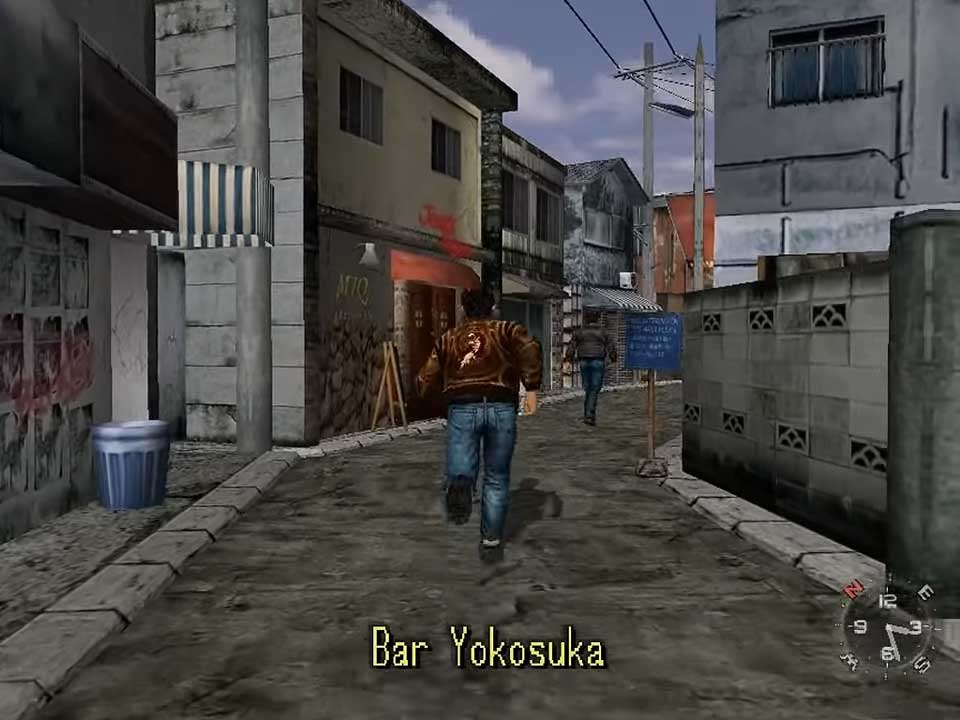
The sixth generation supposes the establishment of the three-dimensional worlds and the improvement of the same year after year. As programmers learned to squeeze the hardware out of consoles, we witness new masterpieces that initially seemed impossible. The definitions were still low, with a maximum of 480p, but obviously at the time that was not a problem for us, it was the best we had seen so far.
The online as we know it today, came to us from the hand of the Xbox fulfilling all our expectations, also coinciding with a time when the internet flat rate was already a standard in most homes, something that was not It happened with the Dreamcast. The only negative aspect is the one mentioned in the previous point, due to the 3D worlds, the games became more difficult to control, at the same time that they became more complex in their mechanics for casual players, this caused many sporadic fans to videogames put down the controls and say goodbye to a hobby that was becoming more and more convoluted.
Well… What are the best games of the sixth generation of consoles?
Well, well, well… Since there are literally thousands of video games and hundreds of good games, we are going to share only a few essentials of the generation:
- Dreamcast: Shenmue I y II, Sonic Adventure, Skies of Arcadia, Jet Set Radio, Ikaruga, REZ.
- PS2: GTA III, Metal Gear Solid 3, Final Fantasy X, DBZ Budokai 3, Devil May Cry, Gran Turismo 3, Silent Hill 2, Shadow of the Colossus.
- Game Cube: Resident Evil 4, Metroid Prime, Pikmin 2, Zelda Twilight Princess, Super Smash Bros Melee, Star Wars Rogue Leader, Mario Kart Double Dash, Animal Crossing.
- Xbox: Halo, Fable, Ninja Gaiden, Shenmue II, GTA: San Andreas, Doom III, Forza Motor Sport.
- Game Boy Advance: Metroid Fusion, Mario & Luigi: Superstar Saga, Golden Sun: The Lost Age, Zelda: The Minish Cap, Mario Kart Super Circuit.
These are just some of the essentials that, if you are video game fans, you must play yes or yes. There are many more, I know, that’s why I never tire of repeating that these video games are only a small selection. The sixth generation is so extensive in terms of its catalog that it is practically unfathomable, something in any case positive for us.
Collect sixth generation consoles
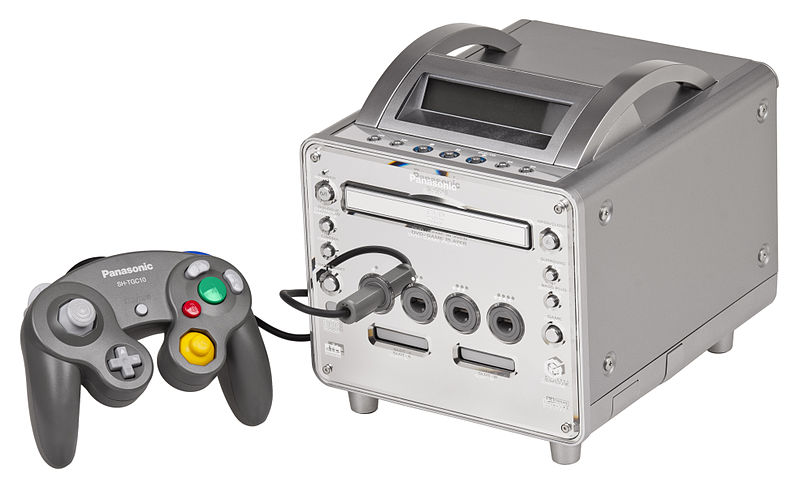
Do you want to collect sixth generation consoles? Well, take advantage now! It is time, the sixth generation sold so many millions of consoles and games that today (2020), despite having almost two decades since its inception, they are totally undervalued. It is enough to see what has happened with the original Game Boy to see what will happen with this generation, it can only go up in price (mainly the PS2 which is rock bottom), so now is the time to start collecting, in a few years you will appreciate it.
When collecting the sixth generation of consoles, we must distinguish between the PS2 and the rest of the consoles:
collect the ps2
With laughable hardware prices and hundreds of games for a few euros in their original box, it’s the perfect time to get a sample of the most representative of this console. As a retro collector, you may not find Sony’s bold enough attractiveness, but a console that is already 20 years old, whether we like it or not, is already a retro console.
And yes, I know that right now they are kicking, even that the safest thing is that you already have your own collection of games and console, but even so at this time we can get a very interesting catalog of games for very little money and in good condition. Consider how much money it costs to get a good NES catalog with its boxes and cartridges in good condition, because that’s what will happen in a few years with the PS2. For the last time, seize the moment.
Collect the Dreamcast, Game Cube and Xbox
How different is the situation of the PS2 and the rest of its contemporaries, while for the PS2 it is a magnificent moment to complete or start our collection, the Sega Dreamcast has gone through the roof, both the console and its games, being right now an object of desire for all of us who turned our backs on it at the time and want to enjoy first-hand its jewels and exclusive games.
The Game Cube follows a path very similar to that of the Dreamcast, having been a console that was rarely played by most players who chose the PS2 at the time, suddenly we find ourselves with a very good Nintendo console, with a catalog of games packed with renowned exclusivities. In other words, the Game Cube has become a candy for all Nintendo players who want to redeem themselves from their PS2 years. And they are absolutely right, that the Game Cube sold little has nothing to do with the quality of its games, besides… It’s so cute!
That said, get a Game Cube as soon as possible, they’re going up and it’s nice.
Interestingly, the original Xbox hasn’t seen a big price hike like its games. The reason is simple, there is no demand. The late departure of the first XBOX and the arrival of the Xbox 360, caused a lack of system loyalty. Now, here we are talking about collecting consoles and as such, having the first Microsoft console is practically mandatory if our collection is generic. The problem of collecting Xbox is very different, acquiring a console will be relatively easy, but with its video games things get quite complicated, not because of the prices, but because they are not found.
The result with the original XBOX is a magnificent console, at a very good price but with immense difficulties to get its most representative games, something extremely strange in such a recent console.
And to end this section, as we always recommend at Infoconsolas, before starting any collection, plan your goals well, see how much they sell for and more importantly, how much money their games and platforms have been bought for, be patient, be realistic in your objectives and do not close yourselves to a single sales channel.
Buy consoles of the sixth generation
Speaking of relatively recent systems, fortunately there is still a lot of genre in many different sales channels: web applications, second-hand websites, retro or specialized stores, flea markets, friends and relatives who have consoles in a closet… For this occasion , from Infoconsolas we recommend you with the following link to buy the SEGA Dreamcast, in the announcement you will be able to see all the Dreamcasts for sale on eBay right now with their updated prices.
For the rest of the sixth generation consoles, depending on what your goal is, you will have to pay more or less. But as we have said before, 128-bit consoles are generally within our reach, and if we talk about the PS2, even more so. Of course, don’t leave it for too long, except for the original XBOX prices are going up, especially for the Dreamcast and Game Cube…
As always happens in the retro world, there are quite unknown consoles that are practically impossible to find at a reasonable price, they are rarities that are at the level of great collectors, it is up to you to prioritize where you allocate your resources.
And if you have come this far, in addition to congratulating you, I invite you to follow us on Twitter, a much more informal space that you will surely like.
FAQ Sixth generation of video game consoles
1998.
Dreamcast.
39,800 yen at launch.
In Japan.
The DVD as a large format, the great capacity to process polygons, the arrival of online to the great public of consoles and the successfully integrated multimedia.
The PlayStation 2 with 160 million units sold worldwide. Crazy.
SONY and his PS2.
DVD, DVD variants and GD-ROM.
Teenagers and adults in addition to the Nintendo children’s classic.
Yes, although the sixth generation consoles definitively knocked down arcade halls all over the world except Japan.
Yes, epic are the comparisons such as Resident Evil 4 for PS2 and GC.
Xbox.
Game Cube.
Yes, the PlayStation 1 was able to put up a fight and outperform Sega’s Dreamcast commercially.
External sources and links
- Console graphics resources: https://commons.wikimedia.org/wiki/User:Evan-Amos

